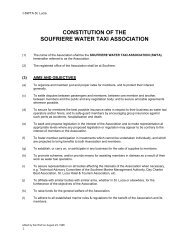WWF Cover photo - Soufriere Marine Management Association ...
WWF Cover photo - Soufriere Marine Management Association ...
WWF Cover photo - Soufriere Marine Management Association ...
You also want an ePaper? Increase the reach of your titles
YUMPU automatically turns print PDFs into web optimized ePapers that Google loves.
important species for recreational fishing in upper North Island and one of the most important commercialfishery species (see Annala and Sullivan 1996, in Millar and Willis 1999). The abundance of snapper larger thanthe minimum legal size was 14 times greater in protected compared to fished areas, and egg production anestimated 18 times higher. In the Leigh <strong>Marine</strong> Reserve, legal-sized snapper were larger than legal-sized snapperin fished areas, but size differences were not significant. Snapper abundance, like that of lobsters, was highlyseasonal with higher densities in autumn than in spring.Willis et al. (2001) explored movement of snapper in the Leigh <strong>Marine</strong> Reserve by tagging fish. They found thatsome show site fidelity to areas only a few metres wide and can occupy the same area for a number of years inthe absence of fishing. Some snapper may move long distances but in the light of the large increases in theirabundance inside the reserve it seems likely that some are permanently resident in the reserve (Willis et al.2001). It is possible that some snappers can be mobile or site-attached and that reserves select for the siteattachedsnapper.Long Island-Kokomohua Reserve, Marlborough SoundThe Long Island-Kokomohua <strong>Marine</strong> Reserve was established in 1993 and a monitoring programme initiated atthe outset. This looked at size, distribution and behaviour of blue cod (Parapercis colias), the most commonedible reef fish, and a popular target for recreational fishers. Sampling was conducted with baited hooks insideand outside reserves from 1993 to 2000, and underwater counts from 1992 to 2001.Cole et al. (2000) studied dispersal of blue cod around the reserve. They found similar densities of fish insideand outside the reserve and that the mean size of fish inside the reserve was 4cm (19%) larger than in the fishedsites (21cm in fished sites vs. 25cm in the reserves). They tagged a sample of 360 fish and 73-75% of resightingsof tagged fish were made within 100m of the tagging sites. Fewer resightings were made in the reserve than atfished sites, even though individuals were not removed from the reserve sites by fishing, suggesting that someblue cod in the reserve move longer distances than those in fished sites. The larger individuals in the reserve andthe limited dispersal of most of the fish indicates that the reserve is increasing survivorship. Cole et al. (2000)suggest that increased sizes within the reserve and sufficient movement via spillover is making these fishavailable to fishers in the adjacent fishing grounds, and therefore conferring fishery benefits.Mean length of blue cod (mm)340320300280260240220ControlsReserves2000 5 10 15 20 25 30 35 40 45 50 55 60 65 70 75 80 85 90Months since reserve establishmentFigure 1: Mean length of blue cod from reserves and control sites fromSeptember 1993 to April 2000. Error bars show 95% confidenceintervals. Redrawn with permission from Davidson 2001.Davidson (2001) used experimental fishing with baited hooks to monitor reserve effects in the Long Island-Kokomohua <strong>Marine</strong> Reserve from September 1993 to April 2000. He found that mean length of blue codincreased from 27.6cm in September 1995 to 31.8cm in September 1999 (a 15% increase), but then decreased toabout 30.5cm by April 2000. Outside the marine reserve mean length decreased from around 25.5cm to around22cm in April 2000, probably in response to the reduction of the minimum legal size at which blue cod could becaught from 33cm to 28cm. The average fish in the reserve was approximately 39% longer than in fishinggrounds after 7 years of protection (Figure 1).44



